Indonesia’s tourism sector continues to be a key pillar of the national economy, contributing significantly to the country’s GDP (Gross Domestic Product). In 2023, this sector accounted for 4.1% of GDP (year-on-year), generating a total revenue of USD 14.63 billion. Following this success, the government targets a growth contribution of 4.5% (y-o-y) by 2024.
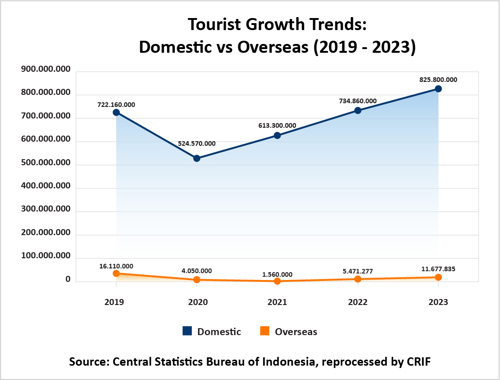
Based on tourist growth trends over recent years, it is evident that the tourism sector is gradually recovering from the impact of the 2019 COVID-19 pandemic. Notably, there was a sharp rise in foreign tourists, with a 250.72% increase in 2022, followed by a further 113.44% increase in 2023. Local governments have also intensified their efforts to attract investors and developers to build new tourism destinations across various regions. According to data from the Central Bureau of Statistics (BPS), in 2023, there were 2,930 tourist attractions in Indonesia, of which 1,003 were man-made, 651 were natural, and 530 were water-based attractions. These destinations are key contributors to the country’s revenue from tourism.
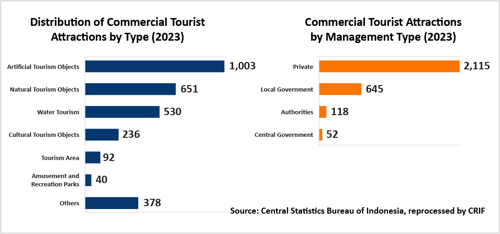
Regarding management, 2,115 attractions are privately managed, 645 are managed by local governments, 118 by special authorities, and 52 by the central government. The sector not only continues to grow but also provides significant employment opportunities. Although the tourism sector faced severe challenges during the COVID-19 pandemic, recovery signs have been visible since the end of 2020, with positive trends continuing into 2023.
2023 Tourism Highlights
These are the following tourist segments became the focus of our local sector:
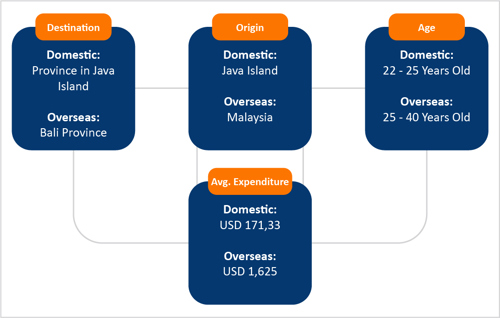
Challenges in the Tourism Sector
-
Declining Savings Rate and Its Impact on Domestic Tourist Growth and Tourism Revenue
As consumers' purchasing power increases, their propensity to save declines, leading to higher vacation budget allocations. The growth and estimates of the vacation budget prepared by the public can be observed from the recorded data on the average expenditure during holidays in recent years.

Based on data from the Central Bureau of Statistics and processed by CRIF, foreign tourist spending has consistently increased. In 2023, foreign tourist spending rose by 12.22% compared to 2022, reaching USD 1,625 per visit. The same trend was observed among domestic tourists, whose spending increased by 5.76% in the same year.
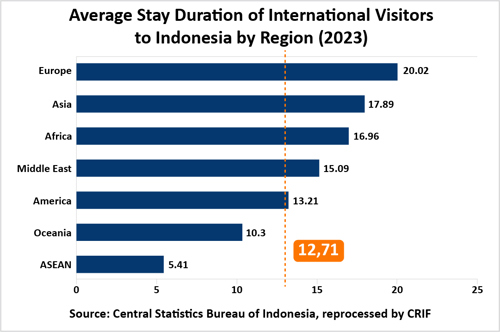
One contributing factor to the rise in foreign tourist spending is the extended duration of their visits. According to BPS data, the average length of stay for foreign tourists in Indonesia in 2023 was 12.71 nights, up from 12.45 nights in 2022. In addition to the longer stay, the per-night expenditure also increased. In 2023, the average spending per night was recorded at USD 127.88, up 26.45% from USD 101.13 the previous year.
2. Lack of Innovation and Limited Variety in Tourism Offerings
The limited diversity in tourist destination development leads to a monotonous experience, even if the locations differ. Several factors hinder innovation in the tourism sector, including:
-
Low community involvement in tourism development
-
Insufficient prioritization of tourism development by local governments
-
Lack of specialized human resources in tourism-related departments
-
Minimal collaboration with investors
-
Ineffective promotional systems
-
Too many tourist attractions copy concepts from other regions, leading to a lack of uniqueness.
3. Ongoing Inflation and Rising Interest Rates
In the past two years, inflation has shown a downward trend, decreasing from 5.47% in February 2023 to 2.13% in July 2024. This indicates a slowing down of price increases in Indonesia during this period. However, this situation contrasts with rising interest rates, which increased from 5.75% to 6.25%. The rise in interest rates has made it more challenging for people to obtain funds and plan vacations, especially without using their savings.
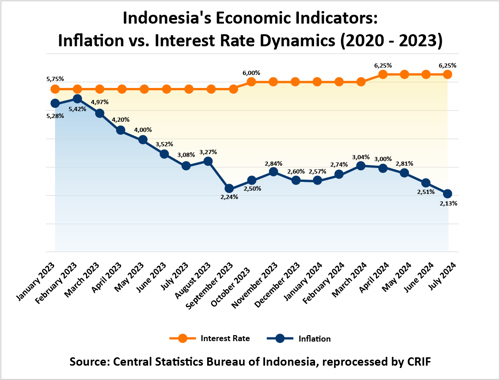
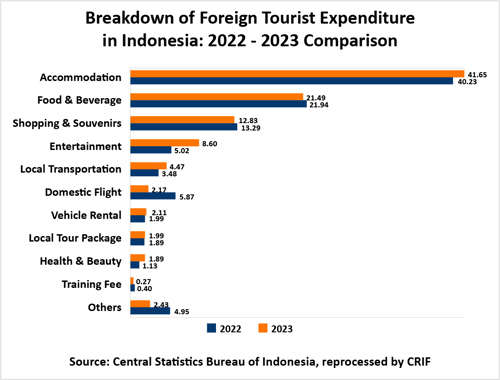
Based on the types of expenditures, the majority of foreign tourists' spending in Indonesia in 2023 went towards accommodation, amounting to USD 676.95 or 41.65% of total spending. This was a 16.20% increase compared to the previous year. The second-largest expense was for food and beverages, reaching USD 349.30 or 21.49% of total spending, which rose by 9.94% from USD 317.72 in 2022.
Tourism Sector Outlook by CRIF Indonesia
Despite growing concerns among business players about the future of the tourism sector, based on current consumer behavior, the sector is expected to experience significant growth in 2024 and 2025, with an average annual growth rate of 16.37%.
According to the Ministry of Tourism and Creative Economy's July report, foreign tourist visits reached 7.75 million, demonstrating that the sector is well-positioned to return to pre-pandemic levels, especially with the restoration of flight routes and increased promotional activities.
Moreover, there has been a shift in tourist behavior. While previously tourism focused on visiting locations and taking photos (recreation), there is now greater awareness of the environmental, socio-cultural, and economic impacts of tourism (contribution). A 2023 survey by Booking.com revealed that 43% of tourists are willing to pay more for sustainable travel options, and 69% hope their spending contributes to the local economy during their travels.
